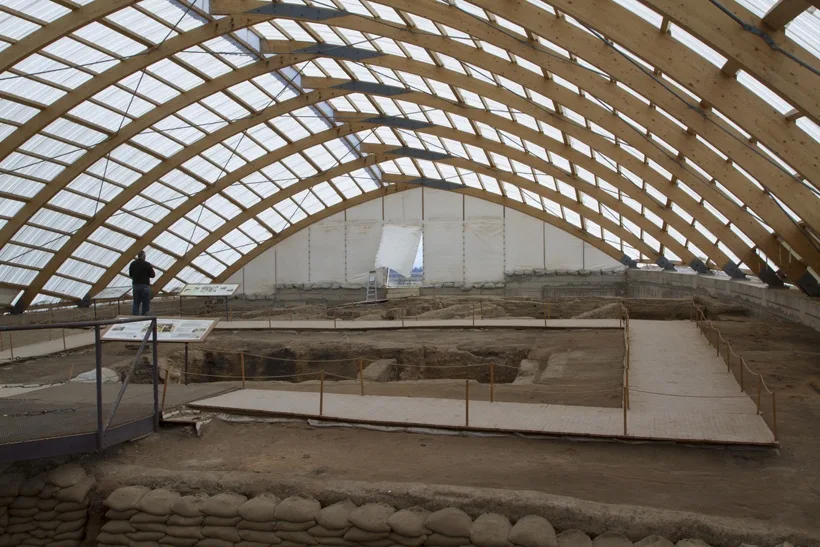Çatalhöyük one of the most important world heritage sites in Turkey…and nobody knows about it…until now!
For some reason, I had a hard time getting to Çatalhöyük, a newly inscribed archaeological site in Turkey. It was located only about three hours from my house in Ankara, and yet it took me four years to get there. I kept putting it off and putting it off.
A good friend of mine moved to Turkey, and it was high on her list so she kept on about it the whole year…and we finally made it. Once I did finally go and walk around the windswept plains, I felt kind of justified. There isn’t much out there.
I had been meaning to get there, but soon after I arrived in Turkey there was the great hoopla over Göbeklitepe, which is dated back 11,000 years, seemingly knocking Çatalhöyük out of the ball park. However, now the powers that be have deduced that Göbeklitepe was the first “church” or religious site whereas Çatalhöyük is still the oldest settlement or in fact, city.

From the parking lot and visitor’s center, there’s a good walk over a dirt path to get to the sites. Höyük means mound, and there are actually two mounds, covering up remains from 9,000 years ago. Thanks to UNESCO, they are now a couple of covered excavation sites that you can easily walk around and see the important bits.
Çatalhöyük literally means “fork mound”, and it is not the name given by the people who founded the civilization so long ago. Nobody knows what they called it. This is a name given by whomever identified the mounds to begin with, long before excavation started in the late 1960’s.

It is best to visit the center and reconstructed house that is near the entrance before heading out to the mounds. The visitor center is very well put together, albeit small. It has a few items that were excavated from the site, although most are now in the nearby Konya museum or the Anatolian Civilizations Museum in Ankara.
There are plenty of signs in English as the main excavators are from the United States. In fact, it is one of the best sites I’ve visited in Turkey, as far as education and learning about the culture is concerned. Another one is Kaman Kalehöyük, which is run by the Japanese and is not on the World Heritage Site List as of yet.

For the few minutes it takes to wander around the visitor’s center, you learn that these particular mounds were parts of a city with a population of around 10,000 people, and that the people just kept building up to the sky instead of outwardly like we do today. They even buried their dead under built up pallets, possibly where they slept themselves.
One of the most significant reasons for World Heritage Site inscription is that at the time the mounds are dated to, over 9,000 years ago, the majority of people on the Earth were nomadic, and here they settled and had figured out how to sustain their lives with agriculture and domesticated animals. Quite a big feat, if you think about it.
Reading about the culture and what to look for in the mounds made the visit there, to what can be likened to a big pile of dirt, all the difference in the world to me. It was fun trying to find all the pieces of the puzzle and put them together to try and help you imagine a real city with people and animals.
I found this excellent educational website about Çatalhöyük and wish I’d been able to explore it more before I went. Now you can.
If you are planning an extended trip through Turkey, I wouldn’t say that Çatalhöyük would be at the top of my list of things to do, but you have to admit, it’s got some good credentials! I’d love to hear what you think if you do go! Leave a comment!

How to go: First get yourself to Konya, which has plenty to see. It is the home of the Whirling Dervishes, a delicious pide called Etli Ekmek, and Rumi’s burial site. Then ask how to take a dolmus (small private bus) to the town of Kucukkoy (literally Little Village) and Catalhoyuk. Having it marked on a google map will help you with this.
During peak tourist season this should be fairly simple. It’s still a lesser known site, and the Turks are not asking for much of an entrance fee. You can expect it to be about 4 Turkish Lira, at least for a few years.
Author Bio: Corinne Vail is a travel photographer, food lover, and a perpetual traveler who has been travel writing for over 14 years. For many years she lived overseas in Germany, Japan, Turkey, South Korea, and the Netherlands teaching the children of the US. military. She’s visited over 90 countries, and she’s not stopping anytime soon.

Have you been to Çatalhöyük?
Pin for later!

